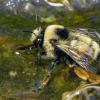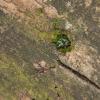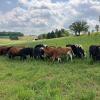In Iowa, less than one-tenth of a percent of our native tallgrass prairie remains, which makes the work I and many others do within the state to protect habitat so important. Many of the remnant prairies left exist in areas that were too difficult to farm due to topography or hydrology, or fall within railroad rights-of-way, roadsides, and pioneer cemeteries.
Over the last several months, I have been able to volunteer in the efforts to save remnant prairie scattered in small pockets within Polk City Cemetery. The cemetery was established in the first half of the nineteenth century on land that even then was unsuitable for plowing—steep dry hillsides formed of sand and gravel left behind by retreating glaciers thousands of years ago. Some parts of the cemetery are unsuitable for graves; it is there that the original prairie survives.
The soils create habitat for prairie flowers that are less common or rare, like the Eastern prickly pear cactus (Opuntia humifusa). The small population of cacti at Polk City Cemetery is the only known record of this plant in Polk county. Herbarium collection data shows only 12 other counties in the state have a record of this species. Unfortunately, the Eastern prickly pear population at Polk City Cemetery has been declining as encroachment of Eastern red cedars and other undesirable woody vegetation increases and deprives the cacti and other native prairie plants of much-needed sunlight. Other hillside prairies are also facing similar struggles.
 A managed fire burning on a prairie remnant in Polk City Cemetery, Iowa. Less than one-tenth of a percent of the state's original prairie now remains, frequently in places such as old cemeteries or steep hillsides. These patches provide home for rare plants, but need management to maintain the conditions the plants need. (Photo: Sarah Nizzi.)
A managed fire burning on a prairie remnant in Polk City Cemetery, Iowa. Less than one-tenth of a percent of the state's original prairie now remains, frequently in places such as old cemeteries or steep hillsides. These patches provide home for rare plants, but need management to maintain the conditions the plants need. (Photo: Sarah Nizzi.)
In the absence of management, trees and shrubs have invaded the remnant prairies, causing each to suffer and become less diverse. In the fall of 2019, I joined a small group of students from Drake University (my alma mater), one Drake professor, and other two volunteers to remove brush and vines from one of the remnant prairie hillsides. This past April I went back to help my friend and former professor burn the brush piles we created and do some prescribed burning (from a safe physical distance, of course). While waiting for our brush piles to burn we investigated the now-open plant community to see what had responded to the fall brush removal. We were encouraged by the results. Seedlings of Culver’s root (Veronicastrum virginicum) and spiderwort (Tradescantia spp.) were in great abundance amongst common early successional wildflowers. Suddenly, a very small flower caught my eye. It looked similar to a violet, but the leaves were different.
The flower species was later identified as a wild pansy (Viola bicolor). A rare native species found on usually disturbed, sandy soils in central, southeast, and south-central Iowa. It stands roughly six inches in height and can be easily overlooked. It is also a larval host plant for butterflies. The wild pansy had not yet been documented at Polk City Cemetery. Once our eyes adjusted to the new addition on the landscape, we soon realized the rare species was scattered throughout the whole hillside where the brush clearing had taken place. As a native plant enthusiast, I was thrilled with this new discovery. I saw this as a sure sign the prairie appreciates the fruits of our labor.

While looking at an area of remnant prairie at the Polk City Cemetery that had been cleared of unwanted plants the previous fall, a tiny plant caught the author’s eye. It was a wild pansy (Viola bicolor), a rare flower that hadn’t been seen on the site before and which was blooming thanks to management efforts. (Photo: Sarah Nizzi.)
Land management is an ongoing process. In order to maintain the diversity of our native ecosystems, we must manage them. If left untouched, invasive and undesirable species will continue to fight for their dominance and they will win. The work left at Polk City Cemetery is plentiful, but not impossible—and well worth the time and sweat. Our efforts to clear more brush continue. I am grateful to be part of the process and anxious to see what the future has in store. Was our discovery of Viola bicolor simply a brief moment in time, only to be seen post disturbance? Will we see it again next spring? Continued management and time may help us find an answer.
I wish everyone the very best in these trying times. I encourage you to engage in restoration work within your communities to refuel the human spirit and to observe the surprises the restoration process has to offer. It is our responsibility to preserve our valuable native ecosystems for the various wildlife species who depend on them and for generations to come.
Further Reading
Read more about Managing Natural Lands for Pollinators
Learn about Managing Roadsides and Rights-of-Way for Pollinators
Sign the Pollinator Protection Pledge




